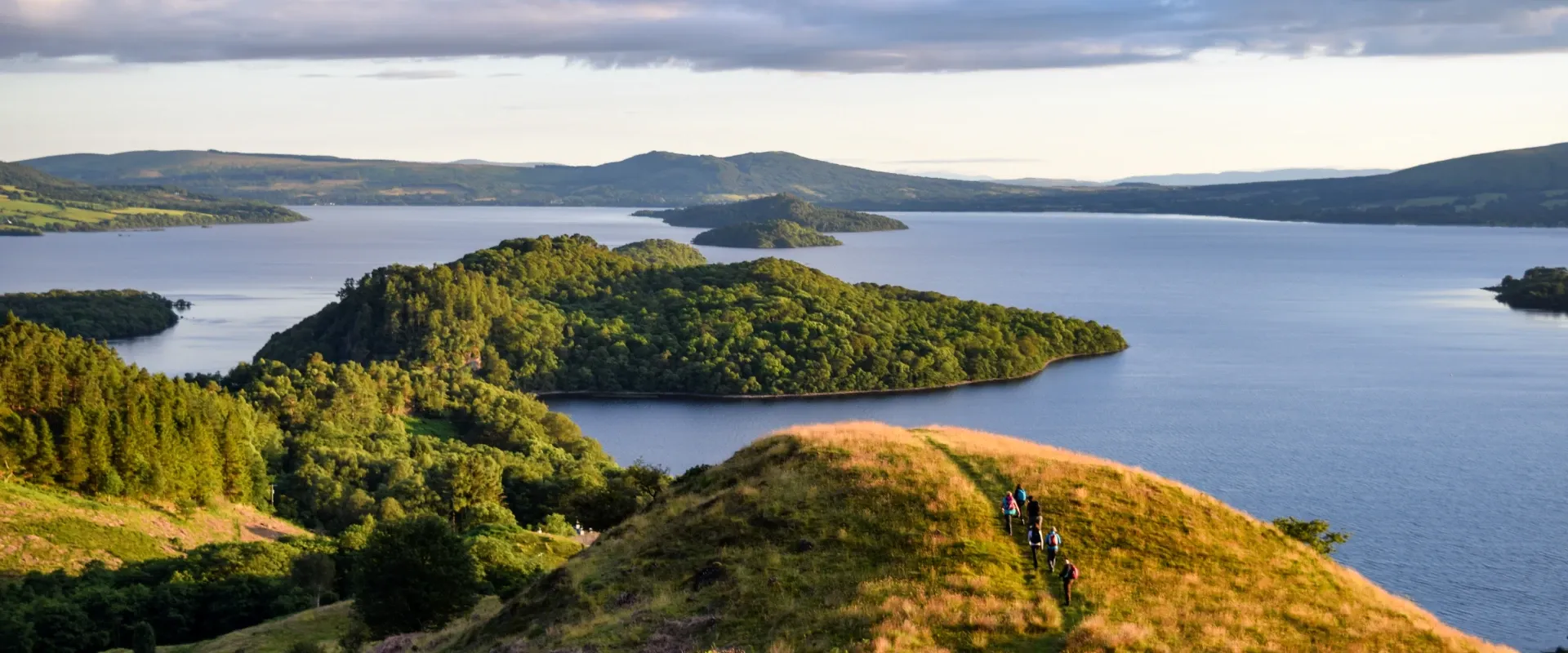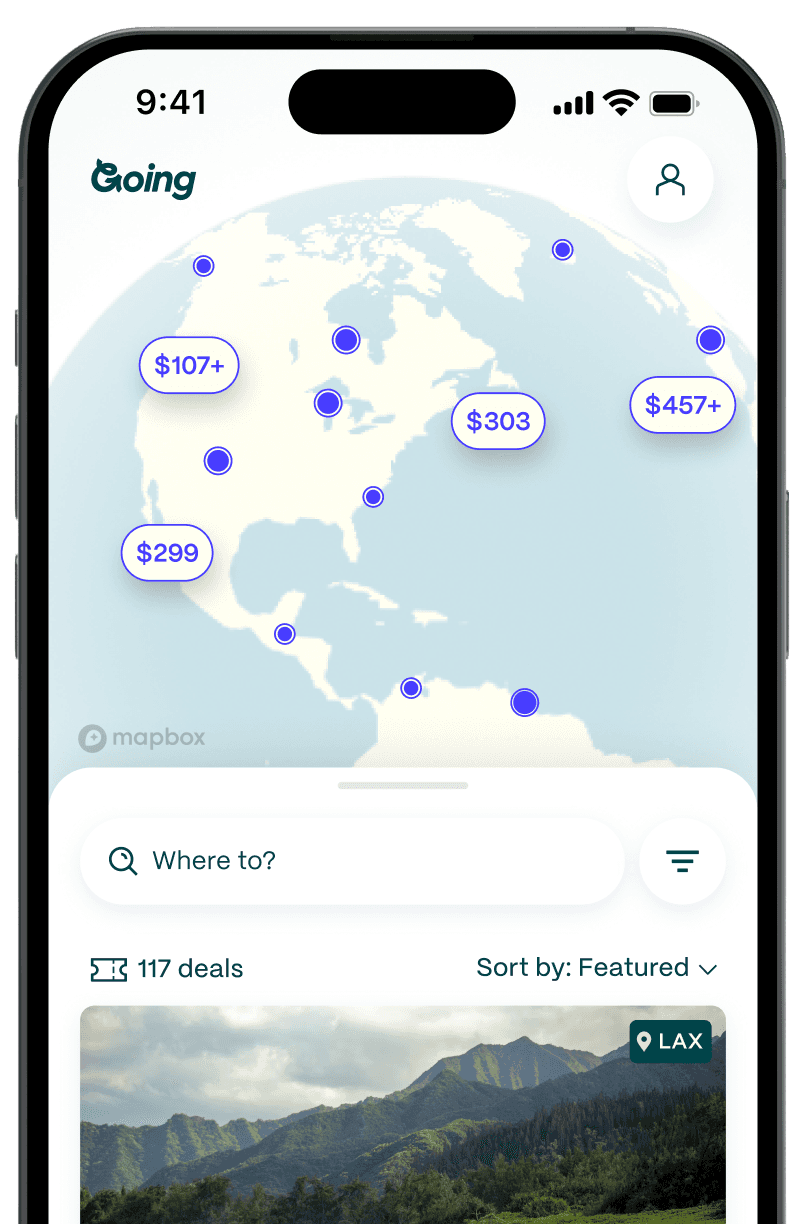
I Hiked Scotland’s 96-Mile West Highland Way. Here's What I Learned
It’s 7am, and I am about to embark on a 16-mile hike through the rugged Scottish Highlands. Do I feel rested? No. Do my feet hurt? Yes. Am I going to make it? That’s anybody’s guess.
It’s day three of seven on a 96-mile trek along Scotland’s first long-distance trail, the West Highland Way, which runs from just outside Glasgow diagonally across the middle of the country to Fort William in the Scottish Highlands, and I wonder if joining the trip was a mistake. One of the guides, David, pats me on the back and says, “Come on Cass, you’ve got this,” and he joins me in the back of the pack, where I will remain the rest of the day, and every day thereafter.
This is one of the most challenging stretches of the route, and for nine laborious hours, we maneuver along steep and slippery slopes, negotiating our balance while climbing up and down inclines completely covered by winding, knotty tree roots. The rough terrain requires increased attention—and intention—but this forced slow down means that I am better attuned to my surroundings. The sky is overcast, and there’s a light drizzle; the scent of rain joins the smell of fresh earth and wildflowers, waking me up and encouraging me to keep going.
We stop at a trading post for lunch, I take off my boots and put my legs up the wall to relieve swelling. Soon after setting out again, the sun peeks out and accompanies us to a rocky beach on the shores of Loch Lomond. We snack on local biscuits and candies the guides have passed out, and David entertains and encourages us with an upbeat song about the “bonnie, bonnie banks of Loch Loooooh-mond.” We’re not even at the halfway point of the day, but the sunshine, warm breeze, and back-of-the-pack jokes I share with David and my soon-to-be hiking BFF, Ryan, keep me going. Our ultimate reward? Scottish beer and fish and chips served by a kilted lad at the iconic Drovers Inn bed and breakfast that night.

A land of mystery, magic, and majesty
The Scottish Highlands are associated with mystery, magic, and majesty, home to kilted clans, fairy folklore, and some of the most stunning views in all of Europe. While there are many ways to explore the area’s history, culture, and nature, I found that the best way was in my hiking boots. During the trek, no two days were the same, no two trails were interchangeable, and no two vistas were identical. The scenery was wild and varied, and I didn’t just encounter it, I engaged with and was consumed by it.
Three days ago, I had started on the trail just eight miles from Glasgow. I joined a fully supported tour with Wilderness Scotland, which booked all the hotels (which often fill up a year in advance), coordinated daily luggage transfers (so I only had to hike with a daypack), and provided two guides for our group of eleven (who were probably the two best guides I’ve ever had in my life).
Within minutes after arriving at the trailhead in Milngavie, I felt immediately transported worlds away. I walked through the brilliantly green Garadhban Forest, running my fingers over moss-covered saplings as I walked through dense woodlands populated with sky-high trees. I climbed Conic Hill and peered out over lupine lochs and verdant valleys. I scrambled over and under enormous tree root systems and rested on beaches along the largest expanse of freshwater in the UK by surface area (Loch Lomond). And this was just the first full day.

Aside from the second day, which included 16 miles of rain, every day was my favorite day, because each day brought a new challenge and a new reward. Every day was intensely challenging, and every day I questioned whether I would make it or not, but the scenery and the friends I was making kept me going and made every step worthwhile.
Wildflower-studded fields led to quaint lochside villages, which led to the appropriately named “Devil’s Staircase” trail, and then to views of the UK’s highest mountain, Ben Nevis. We trekked through muddy forested trails and along gravely military mountain roads, stopping to rest under shady trees or at the impossibly adorable coffee shops in tiny towns. So-called “honesty boxes” were scattered along the trail, allowing us to drop some money in a jar and help ourselves to ice cream, drinks, and snacks. At night, I dined with the other hikers, whom I became good friends with, at quintessential Scottish pubs and restaurants before tucking into warm and welcoming hostels and B&Bs.
One of my guides, the previously mentioned David Bloomfield, says that the West Highland Way is so special, not only because of its status as the first long-distance trail in Scotland but also because it is so accessible. “The paths are well-maintained, and the average hill walker can see some of the most impressive Highlands scenery on a trek that isn’t too difficult.” Keep in mind that the notion of the “average hill walker” is subjective, and this hike is only for experienced trekkers.

Although I’m a very fit, experienced hiker, I still found myself at the back of the pack every day, struggling to keep up but enjoying stories and laughs with Bloomfield and the hiking companions who would soon become friends.
At the front of the pack were three retired British women in their mid-60s who I will idolize for the rest of my life. I can’t imagine doing this hike without a guide and luggage transfer, and I was thrilled to learn that Bloomfield is actually Dr. Bloomfield, an emergency room doctor who doubles as a phenomenally funny wilderness guide who offered nightly foot clinics to help us treat our blisters, aches, and pains.
Despite the damage to my feet (and a bit to my ego from being in the back of the pack), I wouldn't trade this chance to see the wildness of Scotland powered only by my own two feet for all the fish and chips in the world.
Getting there
- The nearest airport is Glasgow International Airport (GLA) in Glasgow, Scotland. To get from here to the start of the trail, catch a ScotRail train from Glasgow Central Station to Milngavie. Trains depart about every half hour, tickets cost a few dollars, and the ride is about 30 minutes. If you’re traveling on a guided tour, groups usually meet at the Glasgow train station and ride together to the start of the route. As flight prices to Edinburgh can sometimes be cheaper and more direct, if you go this route, simply catch a bus from the Edinburgh International Airport (EDI) directly to Glasgow. Buses are frequent, fast, and affordable. You can pay for your bus ticket on board with your credit card, and the ride is about an hour.
- Average Going deal for cheap flights to Glasgow: $545 roundtrip
$900
How to do it
- Best time to go: The best time to trek is April through October. April is cool and midge-free, but the weather can be unpredictable. May tends to be pleasantly warm, dry, and without midges, but it’s busy. June has similar weather but with more midges and fewer people. July and August offer the warmest weather, and there can be a lot of rain or a lot of midges (the upside of the rain is that it keeps away the midges). September has fewer people and midges, and the temperature is pleasant, but it can be wet. October is accompanied by fabulous fall foliage, but it can be cool.
- Cost: Guided 8-day treks cost around $3,400 USD, which includes accommodation, meals, guides, luggage transport, and nearly all costs. The price of a self-guided trip varies dramatically, depending on whether you camp, stay in hostels, or carry your luggage versus paying to have it transferred. It also depends on whether you hire another company to book lodging and luggage transfers for you or you book it yourself. Although you can save some money by booking your own accommodations (as opposed to joining a tour or hiring a company to do it for you), it’s not necessarily a huge amount of money, and because hostels along the route often fill up a year in advance, you may have to invest significant time planning your trip. Budget travelers can save money by camping and eating at wallet-friendly establishments. Wild camping is free in Scotland, but because it’s first come first served, if you arrive at the campsite late, you may be stuck with a less-than-ideal site. Considering how demanding the trek is, it’s especially important to sleep well at night, so if you camp, ensure to pack everything you need to sleep well.
- Safety considerations: Unless you are a very experienced hiker, it is not wise to attempt this hike alone, particularly during the rainy season (July–August). Although the trail is well maintained, some sections can get extremely muddy and slippery and require you to scramble on rocks and climb over knotted tree branches. If you’re an experienced hiker and camper, you could do this trip on your own, but remember that accommodations often fill up a year in advance, and if you camp, it may be in very wet or buggy conditions, so a high-quality, well-ventilated, fully waterproof tent is essential.
- Tips: Bring lots of layers, including fully waterproof boots, pants, jacket, and backpack cover. Even in the middle of summer, the weather can be hot and muggy one day and cold and rainy the next. Weather can be especially volatile on the top of a mountain, and when the wind and rain pick up, the temperature can drop considerably, and it would be dangerous to get wet in the cold. Guided tours typically offer specific packing guides and tips to help you prepare. Also, bring proper hiking boots (not hiking shoes) that are comfortable and broken in. As most days include over 12 miles of trekking through steep terrain, it is not the time to find out that your boots aren’t as comfortable or sturdy as you thought they’d be. Many hikers also bring midge-nets, which are bug-proof hats or veils that keep the bugs away from your face while hiking.
Other adventures around the world
- Beach camping in Vietnam
- Rappel down a waterfall in Lesotho
- Biking 393 miles in South Korea
- Riding the luge in a Michigan adaptive sports park
- Hiking to see the Thailand corpse flower
- Climbing inside a geode in Spain
- Canoeing with hippos in Zimbabwe
- Diving for art in Grenada
- Camping over the Everglades
- Hiking to see El Mirador in Guatemala
Last updated June 10, 2024









